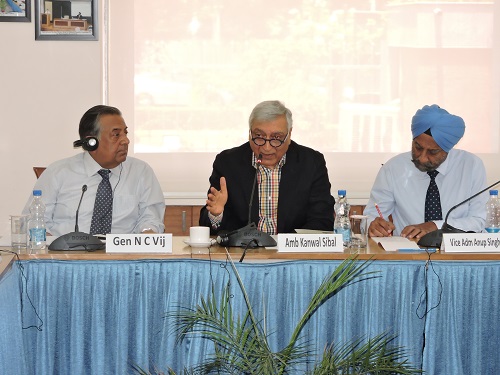The Vivekananda International Foundation (VIF) recently convened a Round Table Discussion (RTD) on ‘India’s Indian Ocean Strategy’. The discussion was intended to examine the steps that India needs to take, to construct a strategy for the Indian Ocean Region (IOR), especially after the Prime Minister had articulated his vision of Security and Growth for All in the Region (SAGAR), in March 2015, at Mauritius. The discussion was attended by a number of luminaries including senior retired diplomatic, naval and government functionaries as also senior serving officers.
Renewed Focus on IOR. The focus of the world on the IOR is witnessing an upward spike because of the strategic importance assigned to it by a few countries.  The discussions highlighted the fact that the Indian Ocean itself has a number of problems which India, as an IOR littoral, has to contend with. These include the susceptibility of India’s energy flows to disruption, piracy, maritime terrorism, drugs and transnational crime as also natural disasters like earthquakes and tsunamis. Considering this vast spectrum of challenges, it was opined that India’s maritime capabilities need to be enhanced commensurately with its increasing responsibilities.
The discussions highlighted the fact that the Indian Ocean itself has a number of problems which India, as an IOR littoral, has to contend with. These include the susceptibility of India’s energy flows to disruption, piracy, maritime terrorism, drugs and transnational crime as also natural disasters like earthquakes and tsunamis. Considering this vast spectrum of challenges, it was opined that India’s maritime capabilities need to be enhanced commensurately with its increasing responsibilities.
SAGAR: Prime Minister Narendra Modi, in 2015, while in Mauritius, had enunciated his vision of SAGAR as a means for furthering the growth and development of the IOR and its littorals. India’s aid to these states during the last four decades in looking after their EEZ by capacity building and capability enhancement was deliberated upon to analyse the effects of such activity. It emerged that a more proactive strategy is the need of the hour to accelerate cooperative development of the region and its littorals.
 Extra-Regional Presence in the IOR. The USA is the only credible power, other than India, in the Indian Ocean. The Joint Strategic Vision for Indo-Pacific, agreed upon by the two nations is an appropriate response to the current and emerging challenges of this region. China has also been forging new relationships with a number of countries in the region besides its ‘all weather friendship’ with Pakistan. The Chinese One Belt One Road initiative is in its nascence and China has yet to enunciate a clear plan for its execution. It was opined that this Chinese initiative, which seems to be aimed at solving the ‘Malacca Dilemma’ may actually result in creating further vulnerabilities for China.
Extra-Regional Presence in the IOR. The USA is the only credible power, other than India, in the Indian Ocean. The Joint Strategic Vision for Indo-Pacific, agreed upon by the two nations is an appropriate response to the current and emerging challenges of this region. China has also been forging new relationships with a number of countries in the region besides its ‘all weather friendship’ with Pakistan. The Chinese One Belt One Road initiative is in its nascence and China has yet to enunciate a clear plan for its execution. It was opined that this Chinese initiative, which seems to be aimed at solving the ‘Malacca Dilemma’ may actually result in creating further vulnerabilities for China.
India’s External Relations in the Indo-Pacific. India has a strong partnership with Japan, especially considering the common maritime challenges. Indonesia is another important country which faces similar challenges as India. Philippines has become a new partner to India while India has also developed good relations with Vietnam, both of whom have strategic value for India. Iran’s return to the international fold, after the  lifting of sanctions, has provide further impetus to its already robust relations with India. It was brought out that India is strategically dependent on the Persian Gulf and its littorals for its energy needs, an area which is also home to a large Indian diaspora whose remittances account for nearly 3 % of our GDP. The necessity for improving connectivity to the Central Asian Region (CAR) states, which are large repositories of energy reserves, was emphasised since such connectivity will not only open up new markets but will also reduce transportation time for Indian goods bound for Europe, by nearly 40 %.
lifting of sanctions, has provide further impetus to its already robust relations with India. It was brought out that India is strategically dependent on the Persian Gulf and its littorals for its energy needs, an area which is also home to a large Indian diaspora whose remittances account for nearly 3 % of our GDP. The necessity for improving connectivity to the Central Asian Region (CAR) states, which are large repositories of energy reserves, was emphasised since such connectivity will not only open up new markets but will also reduce transportation time for Indian goods bound for Europe, by nearly 40 %.
India’s Maritime Economy. India is increasingly becoming a trade and resource dependent nation with most of this trade being carried out by sea. The engagement profile of India’s trade has also shifted in the last two decades with most of our trade, to the extent of 70 %, being conducted with countries of the IOR and the Indo-Pacific. Current government initiatives like “Make in India”, need to look at sectors of the Blue Economy like shipbuilding and port development, to ensure provision of a suitable platform for further supporting and boosting seaborne trade.
 Summary of Recommendations
Summary of Recommendations
The discussions highlighted above, yielded some concrete recommendations for India to discharge its responsibilities towards ensuring security and cooperative development of the region and its littorals. These are broad strategies which warrant further policy directives and the same are outlined below.
Internal Strategy
- Develop capable maritime forces and infrastructure for ensuring effective security for the IOR and its littorals.
- Aid smaller littorals and island states in building up their maritime capabilities and maritime capacities to deal with these challenges.
- Close monitoring SLOCs in the Indian Ocean to meet the region’s security requirements.
- Develop ports and associated infrastructure on the East Coast to exploit the naturally deep waters.
- Develop deep water fishing to improve our exports in this sector.
- Encourage shipbuilding and provide necessary policy incentives.

External Strategy
- Nurture relations with our immediate neighbours and the island nations of the IOR, based on mutual respect and trust, towards ensuring security and cooperative development.
- Prevent proliferation of activities inimical to security and development of the region.
- Cooperative development of regional security mechanism with littoral states of the region.
- Build on the existing good relations with states of the region and further improve the existing military-to-military interactions to generate trust and mutual respect.
- Build synergy between India and likeminded states to mitigate external influences inimical to the interests of the littoral states.
- Build naval ties with friendly countries for protection of our strategic interests in the region.
- Accelerate projects for improving connectivity between the IOR and CAR, thereby gaining access to the CAR and beyond.



